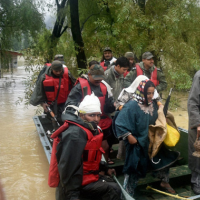Deadly Floods in Jammu & Kashmir, Deforestation to Blame Again
 The Indian Army evacuating stranded people from the flood-affected areas in Srinagar (photo: AP)
The Indian Army evacuating stranded people from the flood-affected areas in Srinagar (photo: AP)
This kind of tragedy seems to be happening with increasing frequency: unusually heavy rain in a mountainous region unleashes floodwater or a landslide that submerges villages and kills many residents. In Uttarakhand last year, near Pune in July, and now in Jammu & Kashmir, the rampant deforestation of India’s hilly areas is being seen as responsible for magnifying these natural disasters.
In Kashmir, four days of torrential rains have unleashed a trail of destruction unseen for six decades, killing 175 people and rendering thousands homeless.
According to the Hindustan Times, deforestation has reduced the water retaining capacity of the land in the Kashmir valley. Fast-running streams now charge down mountains that have been stripped of their green cover, particularly in deforested stretches in Sukh-Nag and Rambyar.
Over the years, the river Jhelum has also been turned into a dumping site with dense human settlements, industries and business establishments coming up on its flood channels. Much of the devastation being seen now is due to the floodplains being built over indiscriminately.
"What we are seeing is increased pressure on land and changes in land use pattern which is affecting the ecology," K Srinivas, head of environment advocacy group Vasudha Foundation, told HT.
Along with this, the area's major lakes – Dal, Nagin and Wular – have been encroached upon and built over.
"Srinagar's inter-linked lakes were designed like a large sponge - as an inlet and outlet for floodwaters. That system has been completely undermined," said Sunita Narain, head of Centre for Science and Environment.
A report last year warned India to stop viewing natural disasters as standalone ‘acts of God’ or of nature, and to recognise that development policies are increasing the number of deaths and amount of devastation in such calamities.
Written by academics, aid workers, scientists and analysts, the India Disasters Report said development works carried out in pursuit of greater economic growth – such as the construction of dams and deforestation – are putting people and the environment at greater risk when disasters strike.
This was seen in the two other major natural disasters in the past year: the massive flooding in Uttarakhand and the landslide near Pune.
Unprecedented rain in June last year wreaked havoc across the state of Uttarakhand, causing rivers and lakes to overflow, inundating towns and villages and killing 6,000 people. Across the state, mountain riverbanks had been frequently built over with roads, hotels and businesses, while small hydropower dams had also taken their toll on the fragile ecology.
Then in July this year, a massive landslide flattened the entire village of Malin near Pune, killing more than 100 people and leaving scores missing. Experts blamed this on extensive deforestation for construction and mining.
A government income generation scheme in the area had required hill slopes to be flattened and thousands of trees to be felled. According to the Hindustan Times, official data indicates that nearly 28,000 trees were cut, but unofficial figures put the figure at 300,000 trees.
“Had there been shrubs or trees, the roots would have bound the mud and red material and the situation would have been averted,” T.N. Singh, a geologist at the Indian Institute of Technology in Mumbai, told The Asian Age.
Reports also suggested that heavy machinery were used to level the slopes, which loosened the soil to such an extent that it impacted the hill’s drainage of water and increased the likelihood of a landslide.
Experts say the construction of hydroelectric dams, deforestation, and the spread of unregulated buildings along riverbanks will magnify the impact of the monsoons.
To Learn More:
Massive rescue operations on as floods cut off J-K; phones down, roads submerged (Hindustan Times)
Flooded with SOS calls, officials in Srinagar throw up their hands (by Bashaarat Masood, The Indian Express)
Uttarakhand to Kashmir, man's folly compounds nature's fury (by Krittivas Mukherjee, Hindustan Times)
Deadly Pune landslide may have been a man-made disaster (by Nita Bhalla, Reuters)
- Top Stories
- Controversies
- Where is the Money Going?
- India and the World
- Appointments and Resignations
- Unusual News
- Latest News
- India College Chain’s Expansion into U.S. Draws Opposition from Massachusetts Officials over Quality of Education
- Milk Shortages in India Tied to Release of New Movies Featuring Nation’s Favorite Stars
- Confusion Swirls around Kashmir Newspaper Ban in Wake of Violent Street Protests
- Polio-Free for 5 Years, India Launches Vaccine Drive after Polio Strain Discovery
- New Aviation Policy Could Increase Service, Lower Ticket Prices





Comments
moreless